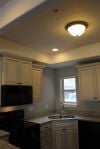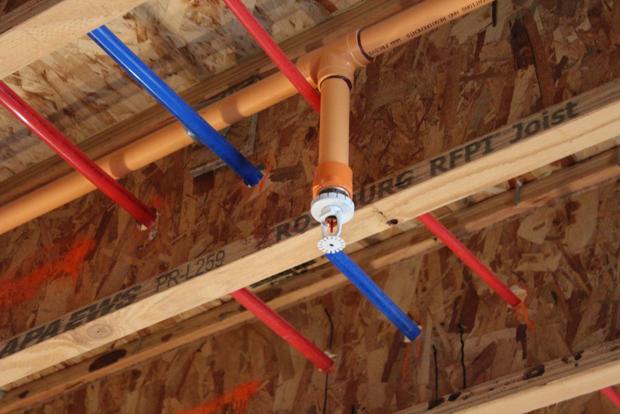ELKO — Just in time for the holiday season, the City of Elko Fire Department and Braemar Construction have announced the installation of the first fire sprinkler systems within a single-family dwelling in Elko.
“The inclusion of residential fire sprinklers in single-family dwellings is a reliable life safety and property protection tool to combat and reduce the fire threat and the risk of mortality,” said Fire Marshal Josh Carson, explaining 80 percent of all fire deaths occur at home.
Braemar built luxury townhomes in what is known as a “cluster home development.” This type of development has narrow streets and does not allow for ease of access with firetrucks. Therefore, as Carson explained, in order to maintain fire safety these dwellings have fire sprinkler systems.
Tuscany Townhomes is located at the intersection of Khoury Lane and East Jennings Way.
These residential sprinklers are the first of their kind in Elko. At this time, only commercial buildings in the city require these systems. Residential systems require them when there are special situations related to fire flow and fire department access.
The systems were installed by the licensed fire protection contractor Extreme Fire Protection from Reno, said Carson.
He explained fire sprinkler contractors are required to be licensed by the Nevada State Contractors Board and the Nevada State Fire Marshal’s Office, and are required to follow local and state fire codes and installation standards.
“This is our first venture with fire sprinklers, as far as the Elko area, so it was kind of a learning process but I have to say it was fairly simple. They’re not complicated at all as far as putting into a home,” said Dusty Shipp, owner of Braemar Construction, explaining the cost was not dramatic, but fairly minimal.
Braemar also received a break on insurance costs by installing these protectants, said Shipp.
These systems are going to continue to be in the building industry by either customer choice or become a standard, he said. In the home the Free Press was able to tour, the sprinklers installed were fairly minimalist and maintained the white color of the ceilings.
Shipp discussed one of the common myths of sprinkler systems — that they cause more harm than fire damage. Shipp said the sprinklers are only activated where the fire is, with the water being distributing from head to head from the piping — so the water damage is contained to the source of the fire.
Carson explained that single-family homes draw water from the initial plumbing system of the house. However, apartments have a dedicated waterline for the sprinklers.
The construction company would like to offer these systems as an option to customers, especially on more custom-built single family homes, said Shipp and Andrew Smith, superintendent for Braemar.
“The system went in as beautiful as the houses that they build,” said Carson.
Fire sprinkler systems help keep fires small to allow residents time to escape and for emergency personnel to arrive.
“The risk of injury or death decreases by approximately 80 percent when the home is equipped with a residential fire sprinkler system. When coupled with a working smoke alarm, residents have a drastic increase of survivability in a fire event,” said Carson.
More than 2,500 people die in home fires each year, according to the NFPA.
Common myths about residential fire sprinklers often deter the public, stakeholders and policy makers from installing or making residential fire sprinklers a requirement of single and two-family dwellings, Carson explained.
These misconceptions include: fire sprinklers are too expensive to install; fire sprinklers go off accidentally; if one sprinkler goes off, they all go off; fire sprinklers cause extensive water damage, worse than fire damage; new homes don’t burn; smoke alarms provide adequate fire safety.
With the inclusion of these systems, many times residents can continue to live in their homes after a fire. Fire sprinklers are even environmentally friendly.
During the construction of the townhomes discussed here, there was an average cost of $2.75 per square foot or $6,875 per unit.
Aside from saving lives, these systems can reduce insurance premiums.
“According the Insurance Services Office Inc. protecting all areas of your home excluding attics, bathrooms, closets, and other areas allowed by code, an 8 percent reduction in premiums can be achieved,” said Carson.
There is a 13 percent reduction for full sprinkler system protection that includes attics, bathrooms, closets and attached structures, according to ISO.
“Home Fire Sprinklers are a valid way to reduce civilian and firefighter injury and fatalities, homeowner insurance premiums and uninsured property loss. Even still, 99.9 percent of homes in the Elko area are not equipped with the same protection as found within our apartments, hotels, and businesses,” concluded Carson, reminding the community that fire safety is a community effort and injury and death can be reduced by taking a “proactive approach.”


